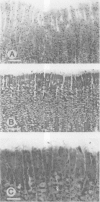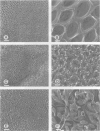Abstract
Capsaicin sensitive afferent neurones have previously been reported to play a part in gastric mucosal protection. The aim of this study was to investigate whether these nociceptive neurones strengthen mucosal defence against injury or promote rapid repair of the damaged mucosa, or both. This hypothesis was examined in anaesthetised rats whose stomachs were perfused with ethanol (25 or 50% in saline, wt/wt) for 30 minutes. The gastric mucosa was inspected 0 and 180 minutes after ethanol had been given at the macroscopic, light, and scanning electron microscopic level. Rapid repair of the ethanol injured gastric mucosa (reduction of deep injury, partial re-epithelialisation of the denuded surface) took place in rats anaesthetised with phenobarbital, but not in those anaesthetised with urethane. Afferent nerve ablation as a result of treating rats with a neurotoxic dose of capsaicin before the experiment significantly aggravated ethanol induced damage as shown by an increase in the area and depth of mucosal erosions. Rapid repair of the injured mucosa, however, as seen in rats anesthetised with phenobarbital 180 minutes after ethanol was given, was similar in capsaicin and vehicle pretreated animals. Ablation of capsaicin sensitive afferent neurones was verified by a depletion of calcitonin gene related peptide from the gastric corpus wall. These findings indicate that nociceptive neurones control mechanisms of defence against acute injury but are not required for rapid repair of injured mucosa.
Full text
PDF
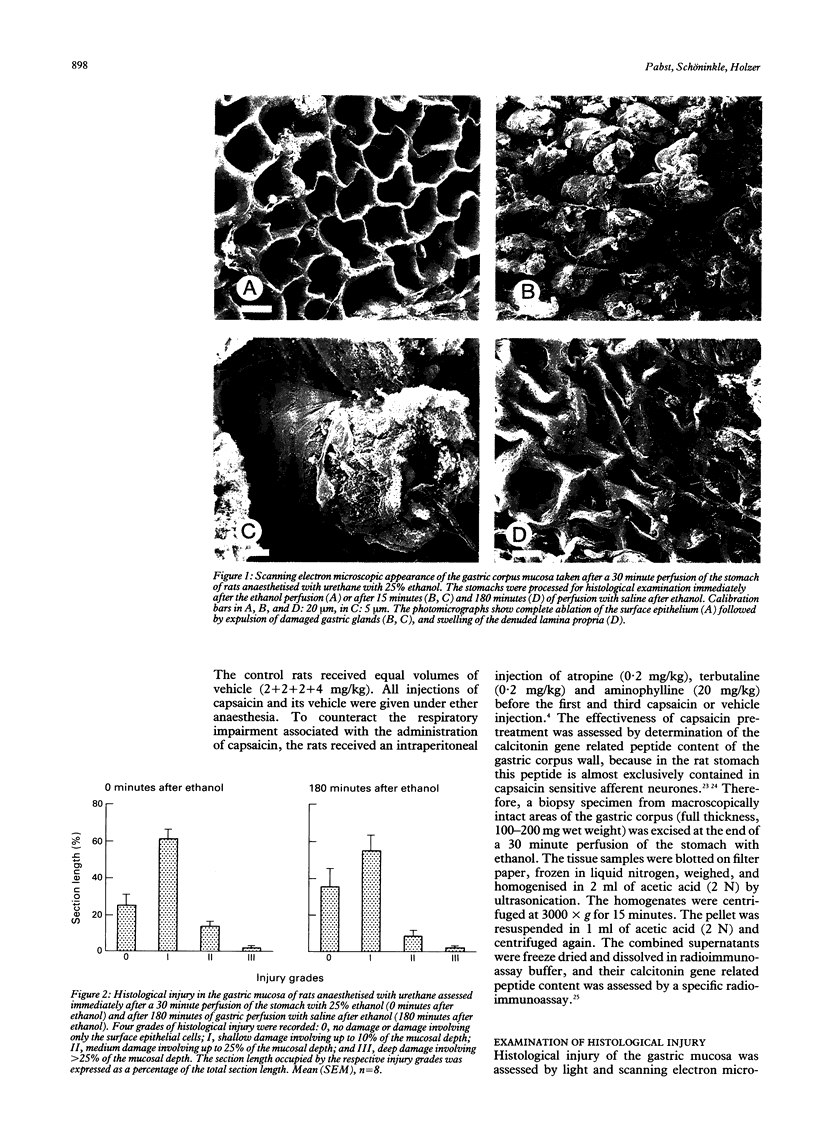
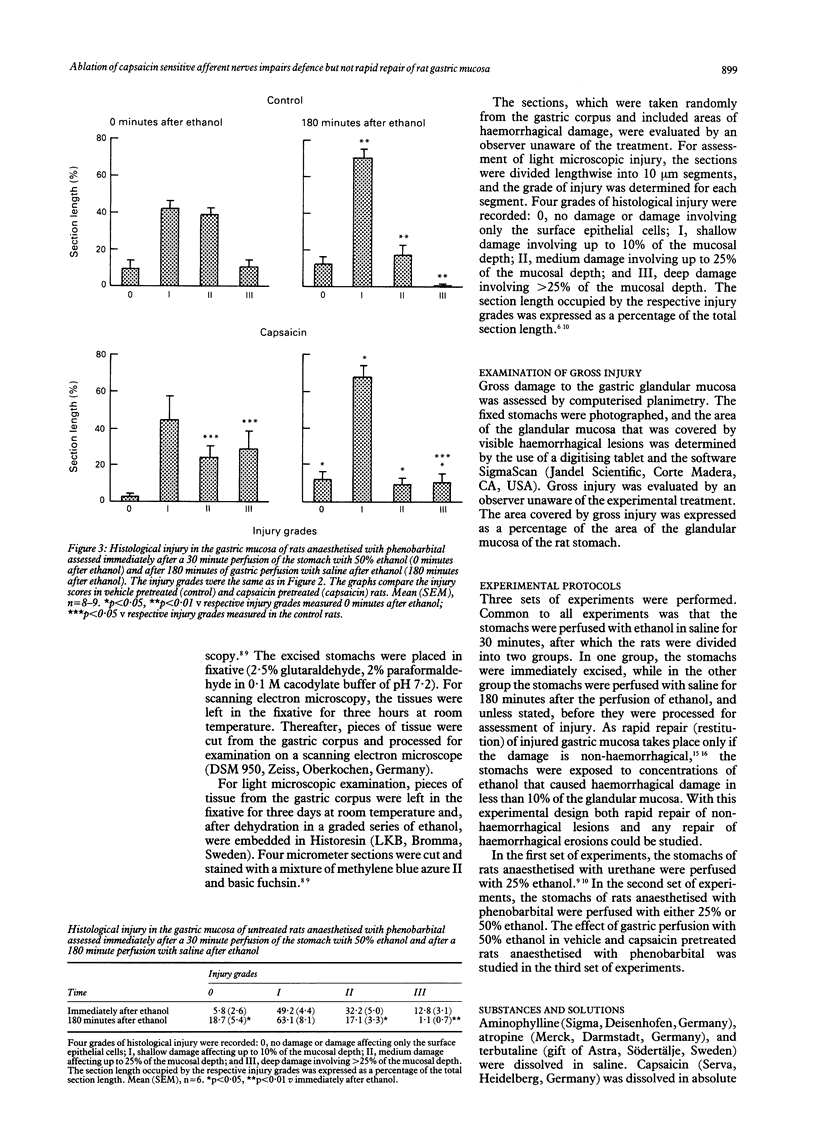
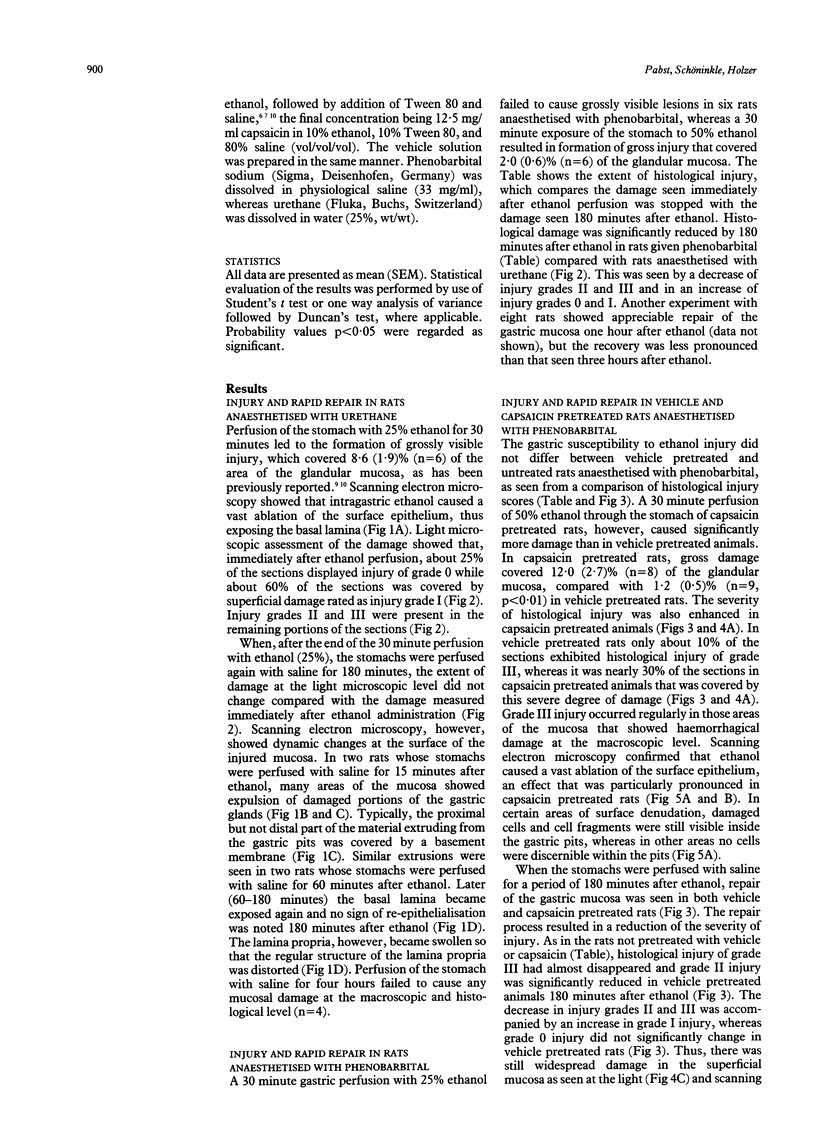


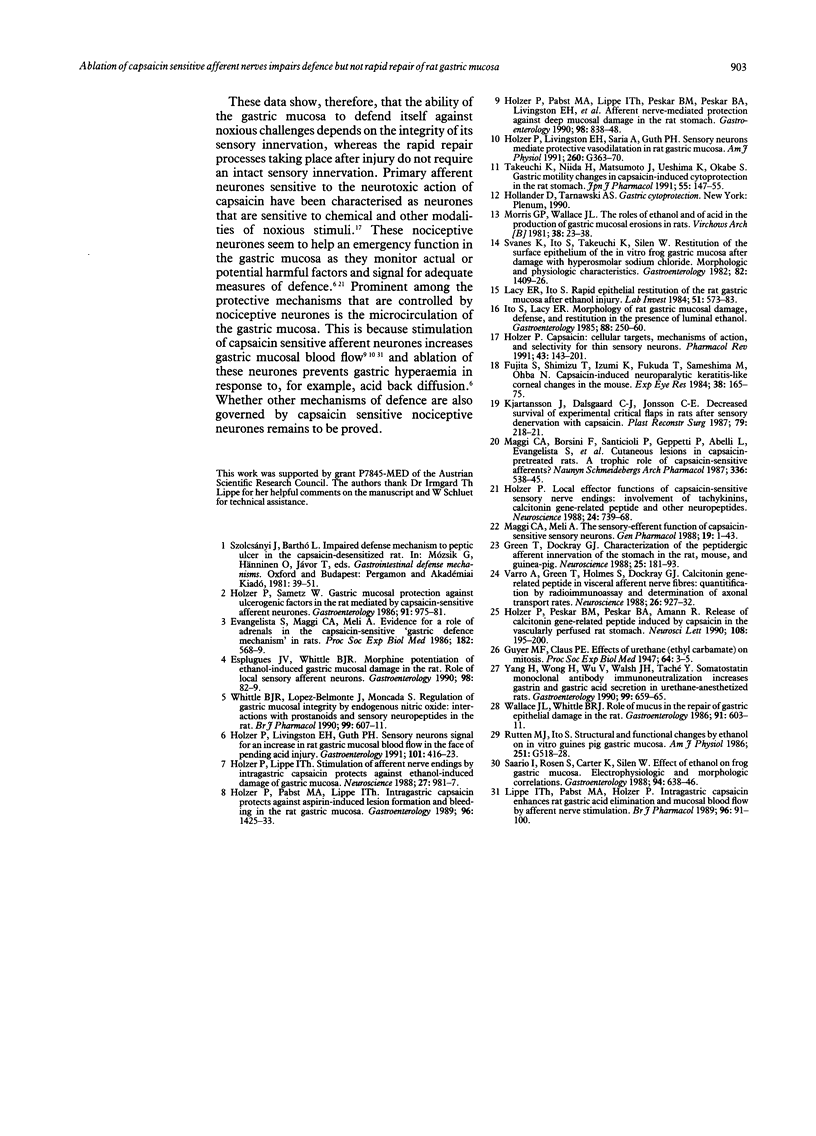
Images in this article
Selected References
These references are in PubMed. This may not be the complete list of references from this article.
- Esplugues J. V., Whittle B. J. Morphine potentiation of ethanol-induced gastric mucosal damage in the rat. Role of local sensory afferent neurons. Gastroenterology. 1990 Jan;98(1):82–89. doi: 10.1016/0016-5085(90)91294-g. [DOI] [PubMed] [Google Scholar]
- Evangelista S., Maggi C. A., Meli A. Evidence for a role of adrenals in the capsaicin-sensitive "gastric defence mechanism" in rats. Proc Soc Exp Biol Med. 1986 Sep;182(4):568–569. doi: 10.3181/00379727-182-4-rc3. [DOI] [PubMed] [Google Scholar]
- Fujita S., Shimizu T., Izumi K., Fukuda T., Sameshima M., Ohba N. Capsaicin-induced neuroparalytic keratitis-like corneal changes in the mouse. Exp Eye Res. 1984 Feb;38(2):165–175. doi: 10.1016/0014-4835(84)90100-3. [DOI] [PubMed] [Google Scholar]
- Green T., Dockray G. J. Characterization of the peptidergic afferent innervation of the stomach in the rat, mouse and guinea-pig. Neuroscience. 1988 Apr;25(1):181–193. doi: 10.1016/0306-4522(88)90017-6. [DOI] [PubMed] [Google Scholar]
- Holzer P. Capsaicin: cellular targets, mechanisms of action, and selectivity for thin sensory neurons. Pharmacol Rev. 1991 Jun;43(2):143–201. [PubMed] [Google Scholar]
- Holzer P., Lippe I. T. Stimulation of afferent nerve endings by intragastric capsaicin protects against ethanol-induced damage of gastric mucosa. Neuroscience. 1988 Dec;27(3):981–987. doi: 10.1016/0306-4522(88)90201-1. [DOI] [PubMed] [Google Scholar]
- Holzer P., Livingston E. H., Guth P. H. Sensory neurons signal for an increase in rat gastric mucosal blood flow in the face of pending acid injury. Gastroenterology. 1991 Aug;101(2):416–423. doi: 10.1016/0016-5085(91)90020-l. [DOI] [PubMed] [Google Scholar]
- Holzer P., Livingston E. H., Saria A., Guth P. H. Sensory neurons mediate protective vasodilatation in rat gastric mucosa. Am J Physiol. 1991 Mar;260(3 Pt 1):G363–G370. doi: 10.1152/ajpgi.1991.260.3.G363. [DOI] [PubMed] [Google Scholar]
- Holzer P. Local effector functions of capsaicin-sensitive sensory nerve endings: involvement of tachykinins, calcitonin gene-related peptide and other neuropeptides. Neuroscience. 1988 Mar;24(3):739–768. doi: 10.1016/0306-4522(88)90064-4. [DOI] [PubMed] [Google Scholar]
- Holzer P., Pabst M. A., Lippe I. T. Intragastric capsaicin protects against aspirin-induced lesion formation and bleeding in the rat gastric mucosa. Gastroenterology. 1989 Jun;96(6):1425–1433. doi: 10.1016/0016-5085(89)90508-8. [DOI] [PubMed] [Google Scholar]
- Holzer P., Pabst M. A., Lippe I. T., Peskar B. M., Peskar B. A., Livingston E. H., Guth P. H. Afferent nerve-mediated protection against deep mucosal damage in the rat stomach. Gastroenterology. 1990 Apr;98(4):838–848. doi: 10.1016/0016-5085(90)90005-l. [DOI] [PubMed] [Google Scholar]
- Holzer P., Peskar B. M., Peskar B. A., Amann R. Release of calcitonin gene-related peptide induced by capsaicin in the vascularly perfused rat stomach. Neurosci Lett. 1990 Jan 1;108(1-2):195–200. doi: 10.1016/0304-3940(90)90730-w. [DOI] [PubMed] [Google Scholar]
- Holzer P., Sametz W. Gastric mucosal protection against ulcerogenic factors in the rat mediated by capsaicin-sensitive afferent neurons. Gastroenterology. 1986 Oct;91(4):975–981. doi: 10.1016/0016-5085(86)90702-x. [DOI] [PubMed] [Google Scholar]
- Ito S., Lacy E. R. Morphology of rat gastric mucosal damage, defense, and restitution in the presence of luminal ethanol. Gastroenterology. 1985 Jan;88(1 Pt 2):250–260. doi: 10.1016/s0016-5085(85)80178-5. [DOI] [PubMed] [Google Scholar]
- Kjartansson J., Dalsgaard C. J., Jonsson C. E. Decreased survival of experimental critical flaps in rats after sensory denervation with capsaicin. Plast Reconstr Surg. 1987 Feb;79(2):218–221. doi: 10.1097/00006534-198702000-00012. [DOI] [PubMed] [Google Scholar]
- Lacy E. R., Ito S. Rapid epithelial restitution of the rat gastric mucosa after ethanol injury. Lab Invest. 1984 Nov;51(5):573–583. [PubMed] [Google Scholar]
- Lippe I. T., Pabst M. A., Holzer P. Intragastric capsaicin enhances rat gastric acid elimination and mucosal blood flow by afferent nerve stimulation. Br J Pharmacol. 1989 Jan;96(1):91–100. doi: 10.1111/j.1476-5381.1989.tb11788.x. [DOI] [PMC free article] [PubMed] [Google Scholar]
- Maggi C. A., Borsini F., Santicioli P., Geppetti P., Abelli L., Evangelista S., Manzini S., Theodorsson-Norheim E., Somma V., Amenta F. Cutaneous lesions in capsaicin-pretreated rats. A trophic role of capsaicin-sensitive afferents? Naunyn Schmiedebergs Arch Pharmacol. 1987 Nov;336(5):538–545. doi: 10.1007/BF00169311. [DOI] [PubMed] [Google Scholar]
- Maggi C. A., Meli A. The sensory-efferent function of capsaicin-sensitive sensory neurons. Gen Pharmacol. 1988;19(1):1–43. doi: 10.1016/0306-3623(88)90002-x. [DOI] [PubMed] [Google Scholar]
- Morris G. P., Wallace J. L. The roles of ethanol and of acid in the production of gastric mucosal erosions in rats. Virchows Arch B Cell Pathol Incl Mol Pathol. 1981;38(1):23–38. doi: 10.1007/BF02892800. [DOI] [PubMed] [Google Scholar]
- Rutten M. J., Ito S. Structural and functional changes by ethanol on in vitro guinea pig gastric mucosa. Am J Physiol. 1986 Oct;251(4 Pt 1):G518–G528. doi: 10.1152/ajpgi.1986.251.4.G518. [DOI] [PubMed] [Google Scholar]
- Saario I., Rosen S., Carter K., Silen W. Effect of ethanol on frog gastric mucosa. Electrophysiologic and morphologic correlations. Gastroenterology. 1988 Mar;94(3):638–646. doi: 10.1016/0016-5085(88)90234-x. [DOI] [PubMed] [Google Scholar]
- Svanes K., Ito S., Takeuchi K., Silen W. Restitution of the surface epithelium of the in vitro frog gastric mucosa after damage with hyperosmolar sodium chloride. Morphologic and physiologic characteristics. Gastroenterology. 1982 Jun;82(6):1409–1426. [PubMed] [Google Scholar]
- Takeuchi K., Niida H., Matsumoto J., Ueshima K., Okabe S. Gastric motility changes in capsaicin-induced cytoprotection in the rat stomach. Jpn J Pharmacol. 1991 Jan;55(1):147–155. doi: 10.1254/jjp.55.147. [DOI] [PubMed] [Google Scholar]
- Varro A., Green T., Holmes S., Dockray G. J. Calcitonin gene-related peptide in visceral afferent nerve fibres: quantification by radioimmunoassay and determination of axonal transport rates. Neuroscience. 1988 Sep;26(3):927–932. doi: 10.1016/0306-4522(88)90109-1. [DOI] [PubMed] [Google Scholar]
- Wallace J. L., Whittle B. J. Role of mucus in the repair of gastric epithelial damage in the rat. Inhibition of epithelial recovery by mucolytic agents. Gastroenterology. 1986 Sep;91(3):603–611. doi: 10.1016/0016-5085(86)90629-3. [DOI] [PubMed] [Google Scholar]
- Whittle B. J., Lopez-Belmonte J., Moncada S. Regulation of gastric mucosal integrity by endogenous nitric oxide: interactions with prostanoids and sensory neuropeptides in the rat. Br J Pharmacol. 1990 Mar;99(3):607–611. doi: 10.1111/j.1476-5381.1990.tb12977.x. [DOI] [PMC free article] [PubMed] [Google Scholar]
- Yang H., Wong H., Wu V., Walsh J. H., Taché Y. Somatostatin monoclonal antibody immunoneutralization increases gastrin and gastric acid secretion in urethane-anesthetized rats. Gastroenterology. 1990 Sep;99(3):659–665. doi: 10.1016/0016-5085(90)90952-w. [DOI] [PubMed] [Google Scholar]




